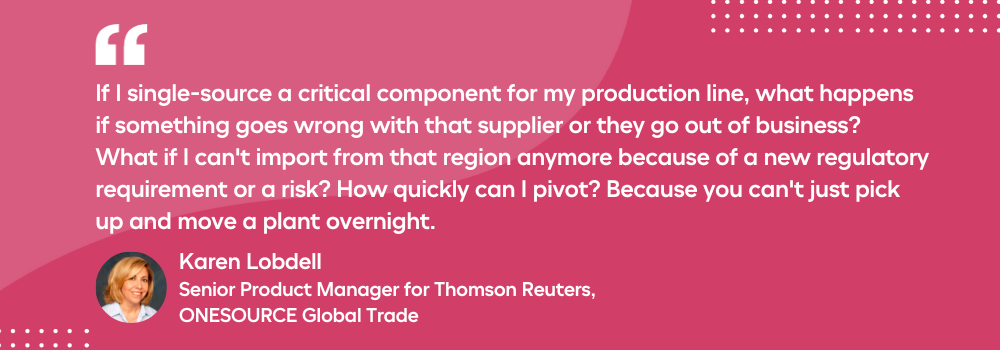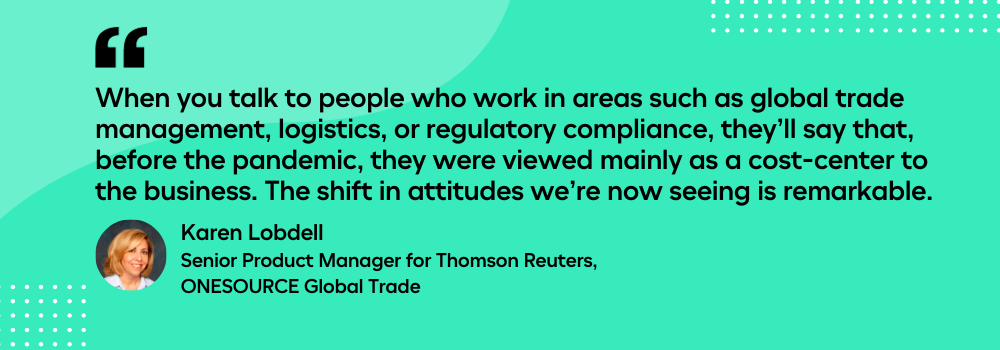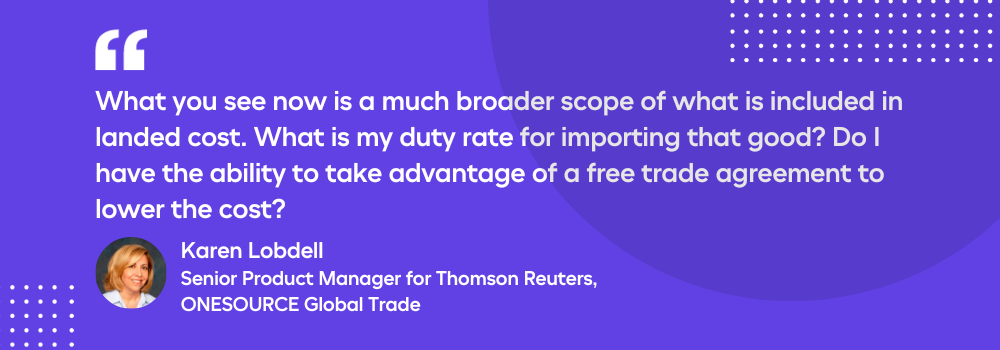Regulatory Compliance: New Rules for Resilient Supply Chains
Regulatory Compliance: The New Rules for Resilient Supply Chains
Following the launch of Tradeshift’s Q3 Index of Trade Health, we invited Karen Lobdell, Senior Product Manager for Thomson Reuters, ONESOURCE Global Trade, to give her perspective on the broad reconfiguration of supply chains we see in our data. Karen delves into how the renewed emphasis on supply chain resilience in the post-pandemic landscape has profoundly reshaped how senior leaders perceive regulatory compliance within corporate strategy. She goes on to explain how a new generation of digitally empowered trade compliance professionals now has the opportunity to shape a more sustainable future for global trade.
Tradeshift is proud to partner with Thomson Reuters ONESOURCE as part of our ongoing commitment to deliver global tax compliance as a service through our platform.
Hi Karen, thank you so much for agreeing to talk to us. Tell us a little bit more about yourself.
I work on the product side for ONESOURCE Global Trade, our global trade management solutions, which includes everything our customers use from a technology standpoint to manage their worldwide trade compliance and duty-savings programs and automate trade operations for cross-border goods anywhere in the world.
I have over 25 years of experience working in global trade policy, logistics, risk management, and consulting. During that time, I’ve covered the whole spectrum of global trade, from the logistics side to the sales side, business development, technology, trade policy, regulatory and legislative.
Our Q3 Trade Index points to a significant reconfiguration across global supply chains. Why do you think that is happening?
Prior to COVID, a lot of supply chains were either single-sourced or heavily sourced in one region or with one country. When that equation broke down, things went awry quickly. Pivoting from one supplier to another isn’t something you can do overnight. Even the lucky ones who did manage to find a new supplier often had to take a significant hit on their costs. More recently, inflation, rising costs, and shortages are playing a key role in supply chain shifts.
The lack of a plan B and even a plan C forced businesses to start asking some pretty hard ‘what if…’ questions.
If I single-source a critical component for my production line, what happens if something goes wrong with that supplier or they go out of business? What if I can’t import from that region anymore because of a new regulatory requirement or a risk? How quickly can I pivot? Because you can’t just pick up and move a plant overnight.
Is it fair to say that the pandemic triggered a change in attitudes toward risk and regulatory compliance?
When you talk to people who work in areas such as global trade management, logistics, or regulatory compliance, they’ll say that, before the pandemic, they were viewed mainly as a cost-center to the business. The shift in attitudes we’re now seeing is remarkable.
The C-Suite is now far more in tune with the impact a disruption in their supply chain can have on their ability to operate. The list of potential risks is varied, and it’s expanding across multiple vectors, from natural disasters and weather-related issues to geopolitical tension and new regulations in areas such as Environmental, Social, and Governance (ESG). We’re also seeing a massive rise in the risk businesses face due to cybersecurity breaches.
The same people who could never get an audience at a senior level are now being called into the boardroom and asked to explain why a certain component now has a 25% tariff on it and what they’re going to do to make the problem go away. They’re now getting the recognition they deserve. They’re also getting the executive support and budgets they need to bring about genuine and long-lasting change.
What additional complexities might businesses encounter as they take a more proactive approach to risk mitigation and resilience across their supplier base?
There’s a lot more to consider. I spent the early part of my career in the logistics space, where decisions were traditionally based on two primary factors: cost and speed. Most people were looking at the cost of purchasing an item from a supplier, moving it from A to B, and the speed at which that item could reach its destination. If you could get really good quality along with that, then that was a bonus.
What you see now is a much broader scope of what is included in landed cost. What is my duty rate for importing that good? Do I have the ability to take advantage of a free trade agreement to lower the cost? There might be government agency fees to consider if it’s something that’s controlled by the Food and Drug Administration, for example. Geopolitical tension means we’re also seeing a rise in governments placing retaliatory fees on items from certain countries.
ESG has also become a major factor in the decision-making process. A good example right now is the intense focus on the social aspect of ESG, such as the allegations of forced labor among the Uyghur population in China. Any goods coming out of that region have the presumption that they’re made with forced labor and, in many countries, prohibited from import. You also have the potential reputational damage from sourcing goods in regions that don’t adhere to high ethical and environmental standards.
Due diligence is absolutely crucial. From both a cost and a risk perspective, businesses need to do their homework, and they need to be able to do so in the most efficient way possible.
What you’ve described sounds complex and potentially very time-consuming. What steps can businesses take to overcome these challenges?
Supply chains are still heavily reliant on paper trails. That’s a barrier to building transparency and automating the processes that feed into effective decision-making. On a positive note, we’re seeing a clear acceleration in the move towards digital.
There are a lot of great tools out there that allow companies to analyze large amounts of their own data, as well as shared data points that are publicly available to give them the insights they need to make informed decisions.
Solutions like the ONESOURCE Trade Lane Analyzer, part of the ONESOURCE Global Trade suite from Thomson Reuters, allow businesses to conduct detailed analysis and scenario planning on sourcing from multiple locations. For businesses evaluating different sourcing options, it will give you a very granular view of all the different considerations you need to factor in, from duty rates to preferential trade agreements, controls and regulations, risk of forced labor, and even elements such as taxes and fees. It’s thorough and digestible at a level that would be almost impossible for any individual to achieve on their own manually.
Businesses can also take advantage of automated regulatory compliance solutions like ONESOURCE Global Trade Supply Chain Compliance to conduct further due diligence assessments on their suppliers based on company values – focusing on key areas of risk such as forced labor, cybersecurity, and environmental practices.
ESG is high on the agenda for most businesses. What are some of the key challenges from a compliance perspective?
Part of the challenge with ESG right now stems from the fact that the regulatory landscape is still evolving. Companies are trying to get their arms around these environmental regulations, but there’s no clear global standard yet regarding how they report. CBAM (Carbon Border Adjustment Mechanism) in Europe is a good example. It’s up to the importer to report the data, but it’s up to the suppliers to provide that data. When suppliers outside Europe start getting requests to provide carbon emissions information, how many will be ready to deliver that information?
What complicates things even further is the question of who owns the problem within a company. Whose responsibility is it to come up with a policy procedure and way to manage the reporting of these environmental requirements? Is it in a sustainability group, a trade compliance group, or a legal group?
With so much uncertainty around ESG reporting, what practical steps can businesses take right now to stay agile?
- Identify owners within your organization. We’re seeing individuals in global trade management and global trade compliance taking a front-foot stance in this area. Given the breadth of ESG as a risk category, one thing that’s clear to me is that this will require a team approach, bringing stakeholders from legal, HR, finance, IT, and beyond. That breadth requires C-Suite oversight. We’re seeing a rise in the number of Chief Sustainability roles created to deal specifically with these issues.
- Digitize your relationships with suppliers. There may be a need for more consistency in terms of how and what businesses should report, but the basic principle of having reliable and transparent data to call on is a constant. If your systems and processes don’t already allow that, you need to make that change now. Think beyond your own four walls and look at how you connect with suppliers through the tiers of your supply chain. Is that connection 100% digital?
- Stay up to date. There are plenty of regulatory compliance technology solutions out there that allow you to monitor regulatory changes coming within the global trade management and compliance arena, such as ONESOURCE Global Trade. Additionally, Thomson Reuters has products that deal with tax and accounting software to help businesses with the tax side. We also have tools for monitoring regulatory issues from a legal perspective. Trade and industry associations are also a great source of information on what’s around the corner. Those communities also provide an excellent way to benchmark with other people within your industry to get best practices.
What role do you see technologies such as generative AI starting to play from a regulatory and compliance perspective?
We’re very focused on how we can use AI to make our products more efficient for our users. And we do this by helping highly trained people make good decisions based on fast and accurate data.
Say you’re working for a business that ships globally—every product you import and export must be appropriately classified under the harmonized tariff schedule. Classification is usually a challenging and lengthy process where someone must have good subject matter expertise. AI won’t necessarily give you a 100% final answer on classification codes (at least not yet), but what it will do is take the data you have and narrow the focus down to a handful of trustworthy options.
If we’re talking about regulation and compliance, then the development and usage of AI is a topic in itself. This is a fast-evolving area. We need to be certain that the data that any AI provides is genuinely accurate and that it’s secure. We must also consider the general public’s concerns over how AI is used.
Finally, compliance is often (unfairly) seen as a tick-box exercise. Do you think that perception has now changed?
Definitely, there’s been a massive shift in mindset from seeing compliance as a necessary expense to viewing it as a source of cost savings. Add to that the reputational risk that businesses face from a lack of due diligence, and it’s no exaggeration to say that compliance is vital to running a viable business.
Global compliance is now firmly on the C-Suite agenda. The risks are too abundant, and the cost of failure is too great to ignore.



